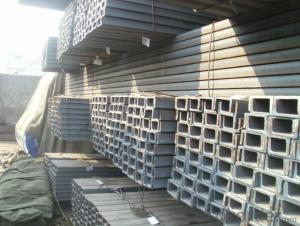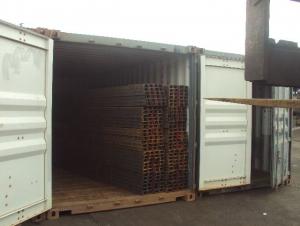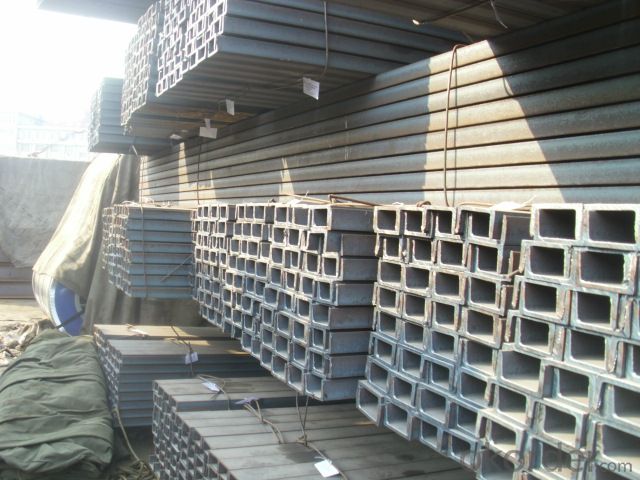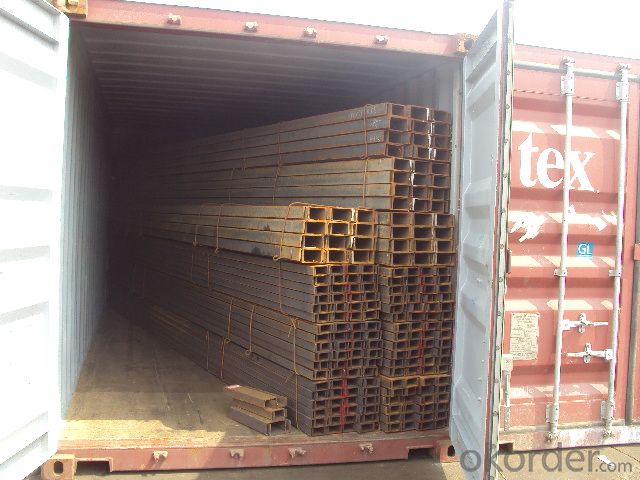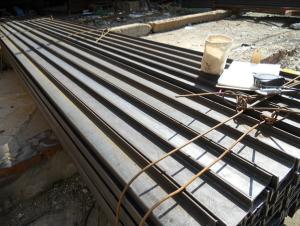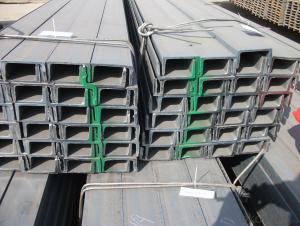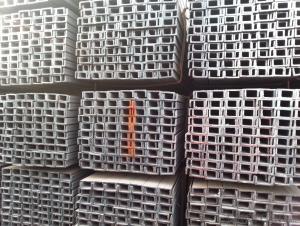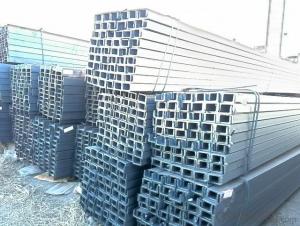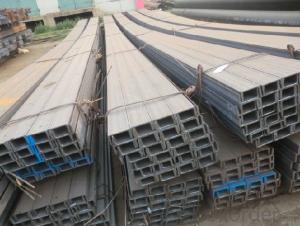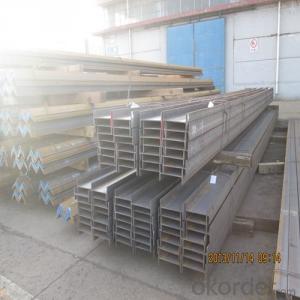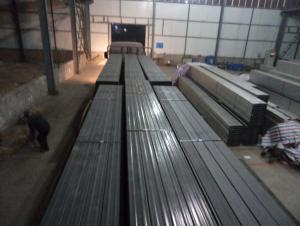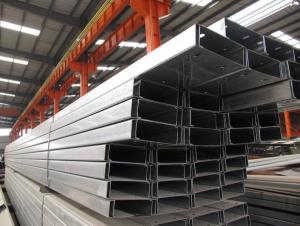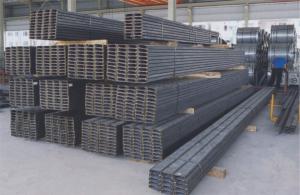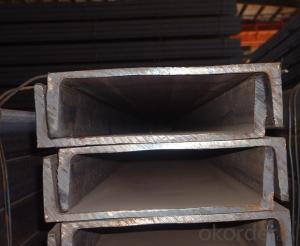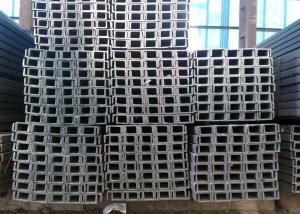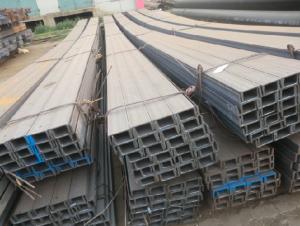U-channel JIS Standard with High Quality
- Loading Port:
- Tianjin
- Payment Terms:
- TT or LC
- Min Order Qty:
- 25 m.t.
- Supply Capability:
- 1000 m.t./month
OKorder Service Pledge
OKorder Financial Service
You Might Also Like
Product Description:
OKorder is offering U-channel at great prices with worldwide shipping. Our supplier is a world-class manufacturer of steel, with our products utilized the world over. OKorder annually supplies products to European, North American and Asian markets. We provide quotations within 24 hours of receiving an inquiry and guarantee competitive prices.
Product Applications:
1.The JIS channel can be devided into two kinds, namely common channel steel and light channel steel. The sizes of hot rolled common channel steel range from 5# to 40#. Meanwhile, the channel steel can be divided into cold forming sectional equal channel steel, cold forming sectional unequal channel steel, cold forming inner edge channel steel and outer edge channel steel.
2.The JIS channel is usually used for arch-itechtural structure, and they could be welded in order to support or hang a vari-ety of facilities. They are also usually used in combination with I beam. The channel steel with sizes under 14# is usually applied to construction engineering, as purline, while the channel steel with sizes above 16# is more likely to be used in building vehicle chassis structure and mechanical structure. Furthermore, the channel steel in sizes above 30# are target at building bridge structure, as tension bar.
3.In a word, the channel steel must possess perfect welding property, riveting property and mechanical property and so on.
Product Advantages:
OKorder's U-channel are durable, strong, and resist corrosion.
Main Product Features:
· Premium quality
· Prompt delivery & seaworthy packing (30 days after receiving deposit)
· Corrosion resistance
· Can be recycled and reused
· Mill test certification
· Professional Service
· Competitive pricing
Product Specifications:
1. We are definitely speciallizing in manufacturing and supplying channel steel as per japanese standard, which is characterised with high mechanical strength and competitive prices.
2. The sections in details are as followings in the table-1
JIS CHANNEL | Standard h | Sectional b | Dimension s | t | Mass: Kg/m |
(mm) | (mm) | (mm) | (mm) | ||
50x25 | 50 | 25 | 3.0 | 6.00 | 2.37 |
75X40 | 75 | 40 | 3.8 | 7.00 | 5.30 |
75X40 | 75 | 40 | 4.0 | 7.00 | 5.60 |
75X40 | 75 | 40 | 4.5 | 7.00 | 5.85 |
75X40 | 75 | 40 | 5.0 | 7.00 | 6.92 |
100X50 | 100 | 50 | 3.8 | 6.00 | 7.30 |
100X50 | 100 | 50 | 4.2 | 6.00 | 8.03 |
100X50 | 100 | 50 | 4.5 | 7.50 | 8.97 |
100X50 | 100 | 50 | 5.0 | 7.50 | 9.36 |
125X65 | 125 | 65 | 5.2 | 6.80 | 11.66 |
125X65 | 125 | 65 | 5.3 | 6.80 | 12.17 |
125X65 | 125 | 65 | 5.5 | 8.00 | 12.91 |
125X65 | 125 | 65 | 6.0 | 8.00 | 13.40 |
150x75 | 150 | 75 | 5.5 | 7.30 | 14.66 |
150x75 | 150 | 75 | 5.7 | 10.00 | 16.71 |
150x75 | 150 | 75 | 6.0 | 10.00 | 17.90 |
150x75 | 150 | 75 | 6.5 | 10.00 | 18.60 |
150x75 | 150 | 75 | 6.5 | 10.00 | 24.00 |
200X80 | 200 | 80 | 7.5 | 11.00 | 24.60 |
FAQ:
Q1: How soon can we receive the product after purchase?
A1: Within three days of placing an order, we will begin production. The specific shipping date is dependent upon international and government factors, but is typically 7 to 10 workdays.
Q2: What makes stainless steel stainless?
A2: Stainless steel must contain at least 10.5 % chromium. It is this element that reacts with the oxygen in the air to form a complex chrome-oxide surface layer that is invisible but strong enough to prevent further oxygen from "staining" (rusting) the surface. Higher levels of chromium and the addition of other alloying elements such as nickel and molybdenum enhance this surface layer and improve the corrosion resistance of the stainless material.
Q3: Can stainless steel rust?
A3: Stainless does not "rust" as you think of regular steel rusting with a red oxide on the surface that flakes off. If you see red rust it is probably due to some iron particles that have contaminated the surface of the stainless steel and it is these iron particles that are rusting. Look at the source of the rusting and see if you can remove it from the surface.
Images:
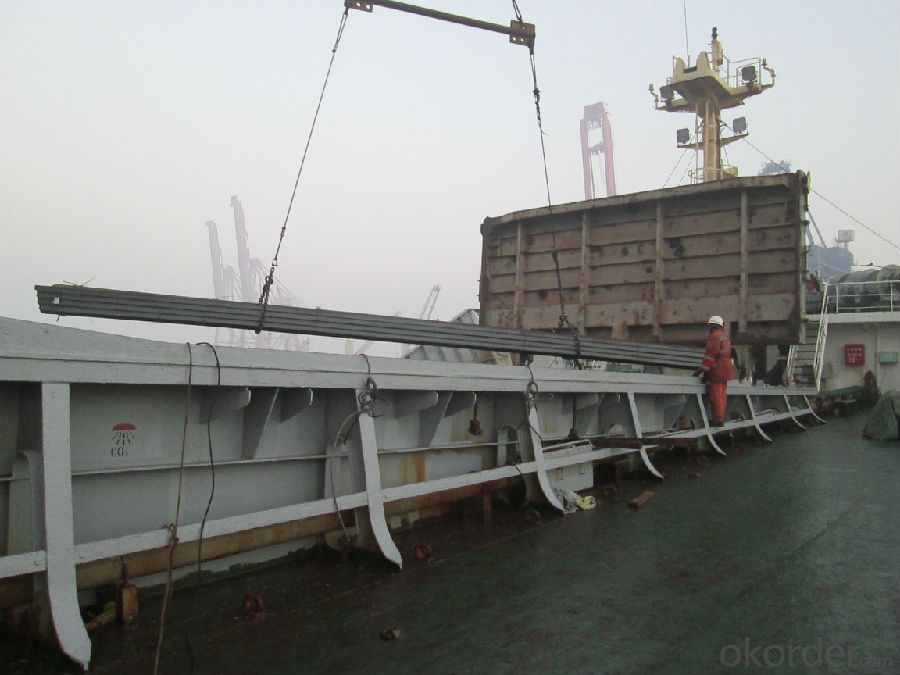
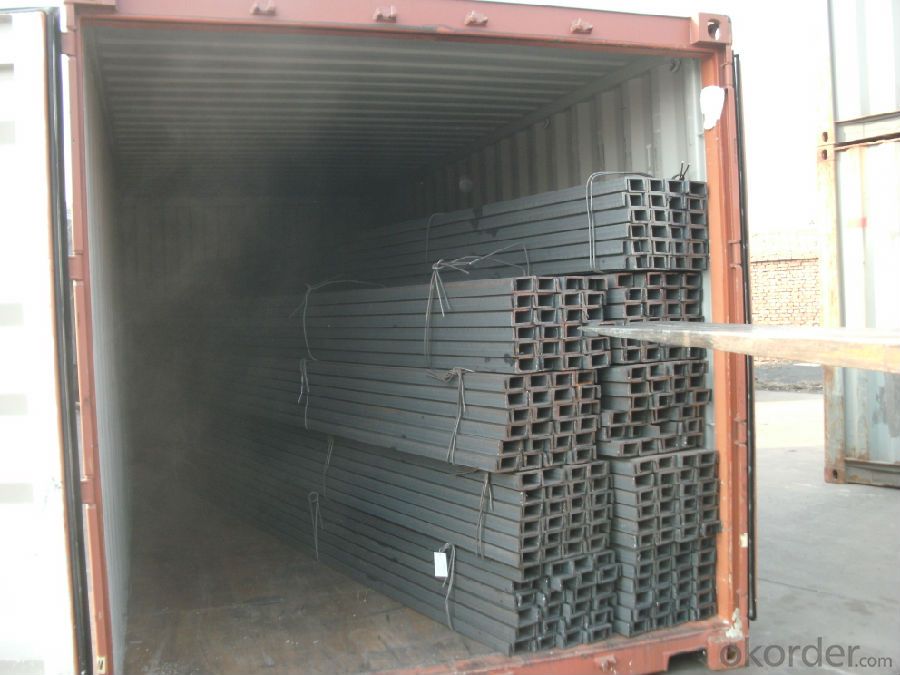
- Q: What are the different methods of cutting steel channels?
- There are several different methods of cutting steel channels, depending on the specific requirements and tools available. Some common methods include: 1. Manual Cutting: This involves using hand tools such as hacksaws, bolt cutters, or shears to cut through the steel channels. This method is suitable for smaller projects or when only a few cuts are needed. 2. Plasma Cutting: Plasma cutting uses a high-velocity jet of ionized gas (plasma) to cut through steel channels. This method is fast, precise, and can be used for both straight and curved cuts. Plasma cutting is typically done with a CNC plasma cutting machine for larger projects. 3. Laser Cutting: Laser cutting uses a high-powered laser beam to melt or vaporize the steel channels, creating a precise cut. This method is efficient, produces clean edges, and is suitable for both thick and thin steel channels. Laser cutting is commonly used in industrial applications. 4. Waterjet Cutting: Waterjet cutting utilizes a high-pressure stream of water mixed with abrasive particles to cut through steel channels. This method is versatile, as it can cut through various thicknesses and materials, including steel. Waterjet cutting is known for its accuracy and ability to create complex shapes. 5. Saw Cutting: Saw cutting is a traditional method that involves using a circular saw or band saw with a blade specifically designed for cutting metal. This method is suitable for straight cuts and can be used for both thin and thick steel channels. 6. Oxy-Fuel Cutting: Oxy-fuel cutting involves using a mixture of fuel gas and oxygen to heat the steel channels to their ignition point, then introducing a high-pressure stream of oxygen to create a cut. This method is primarily used for cutting thicker steel channels and is commonly used in heavy industrial applications. It's important to consider factors such as the required precision, speed, and budget when choosing a cutting method for steel channels.
- Q: Can steel channels be used for creating staircases or handrails?
- Yes, steel channels can be used for creating staircases or handrails. Steel channels provide structural strength and durability, making them suitable for supporting the weight and ensuring the stability of staircases and handrails. Additionally, steel channels can be easily customized and fabricated into various shapes and sizes to meet the specific requirements of the staircase or handrail design.
- Q: What are the different surface treatment processes for steel channels?
- Steel channels can undergo various surface treatment processes to enhance their durability, appearance, and corrosion resistance. Some common methods for treating steel channels include the following: 1. Galvanization: This technique involves immersing the steel channel in molten zinc to create a protective layer that resists corrosion. Galvanization effectively prevents rust formation and extends the lifespan of steel channels. 2. Powder coating: By electrostatically applying a dry powder to the steel channel and then heating it, a durable and smooth coating is formed. Powder coating offers exceptional resistance to corrosion, impact, and UV damage. Additionally, it provides a wide range of color options for aesthetic purposes. 3. Painting: Painting is a popular surface treatment process for steel channels. It entails applying a layer of paint to the surface, which acts as a barrier against moisture and other environmental factors, thereby preventing corrosion. Depending on specific requirements, different types of paints such as epoxy, polyurethane, or acrylic can be used. 4. Anodizing: Although primarily used for aluminum, anodizing can also be applied to steel channels. This process involves immersing the steel channel in an electrolytic bath and passing an electric current through it to create a protective oxide layer. Anodizing improves corrosion resistance and enhances the appearance of steel channels by creating a smooth and decorative finish. 5. Passivation: Passivation is a chemical process that eliminates iron contaminants from the surface of steel channels, enhancing their corrosion resistance. Typically, this process involves treating the steel channel with acid or other chemical agents to remove impurities that could potentially lead to corrosion. These surface treatment processes should be selected based on the specific requirements of the steel channel, including its intended use, environmental conditions, and desired appearance. Each process offers distinct advantages and significantly improves the performance and longevity of steel channels.
- Q: How do you calculate the moment of inertia for steel channels?
- The moment of inertia for steel channels can be calculated using the standard formula for the moment of inertia of a beam. This formula takes into account the dimensions of the channel and the distribution of its mass. The specific formula for calculating the moment of inertia of a steel channel can be found in engineering handbooks or online resources.
- Q: Can steel channels be used for guardrail systems?
- Indeed, guardrail systems can make effective use of steel channels. Given their robustness and endurance, steel channels frequently find application in construction and infrastructure endeavors. They offer a stable base and reinforcement for guardrail systems, thereby guaranteeing the safety and safeguarding of both pedestrians and vehicles. The fabrication and installation of steel channels are uncomplicated, rendering them a prudent and economical option for guardrail systems. Furthermore, steel channels exhibit remarkable resilience against inclement weather and corrosion, rendering them ideal for extended use in outdoor settings. In conclusion, steel channels are a dependable and widely employed material for the construction of guardrail systems.
- Q: How do steel channels contribute to the overall stability of a building?
- Steel channels contribute to the overall stability of a building by providing structural support and load-bearing capabilities. They are often used as beams or columns in construction, helping to distribute the weight of the building evenly and efficiently. The rigid and durable nature of steel channels enhances the building's ability to withstand external forces such as wind, earthquakes, or heavy loads, ensuring its stability and structural integrity.
- Q: 24 meters long, 4 meters per column, 6 meters wide. How large channel steel should be used to make the beam?
- It is assumed that the channel material is Q235, model 14a, vertical, 3.5m, center force, and the maximum load is P.
- Q: Can steel channels be used for conveyor systems?
- Yes, steel channels can be used for conveyor systems. Steel channels are commonly used in conveyor systems due to their strength, durability, and versatility. They provide a sturdy framework for supporting and guiding the conveyor belt or other materials being transported. Steel channels are also compatible with various components and accessories, such as rollers, brackets, and supports, allowing for easy customization and integration into conveyor systems. Additionally, steel channels are resistant to wear, corrosion, and damage, making them suitable for heavy-duty and high-demand applications.
- Q: What are the different methods of surface treatment for steel channels?
- Steel channels can be subjected to various surface treatment methods, each with its own unique advantages and characteristics. Some commonly used methods include: 1. Hot-dip galvanizing: In this method, steel channels are immersed in molten zinc, resulting in a zinc coating that offers exceptional corrosion resistance and protects against rust and other environmental factors. It is a popular choice for outdoor applications that require long-lasting durability. 2. Powder coating: This dry finishing process involves electrostatically applying a powdered polymer to steel channels, which is then cured under heat. Powder coating provides a durable and visually appealing finish, with a wide range of colors and textures available. It also offers excellent resistance to chipping, scratching, and fading. 3. Electroplating: Through an electrochemical process, a thin layer of metal, such as chromium or nickel, is deposited onto the surface of steel channels. This method enhances corrosion resistance, improves appearance, and can even increase the hardness and wear resistance of the steel. 4. Paint coating: A common method involves applying a layer of paint to the surface of steel channels. This not only provides a decorative finish but also protects against corrosion and weathering. Different types of paints, such as epoxy, acrylic, or polyurethane, can be used based on specific application requirements. 5. Anodizing: Although primarily used for aluminum, anodizing can also be applied to steel channels. Through an electrochemical reaction, an oxide layer is formed on the metal surface. Anodizing improves corrosion resistance, provides a decorative finish, and can enhance wear resistance. 6. Phosphating: This chemical process entails applying a phosphate coating to the surface of steel channels. Phosphating improves paint or coating adhesion, provides a protective layer against corrosion, and can enhance lubricity. Each surface treatment method for steel channels offers its own advantages and is suitable for different applications. The choice of treatment method depends on factors such as intended use, environmental conditions, and desired appearance and performance characteristics.
- Q: What does "channel 160*60*20*2.5" mean in steel roof trusses? What is the specific weight?
- Stands for 160mm height, 60mm width, and 2.5mm thickness, and 20mm is the size of two small ears.
Send your message to us
U-channel JIS Standard with High Quality
- Loading Port:
- Tianjin
- Payment Terms:
- TT or LC
- Min Order Qty:
- 25 m.t.
- Supply Capability:
- 1000 m.t./month
OKorder Service Pledge
OKorder Financial Service
Similar products
Hot products
Hot Searches
Related keywords
